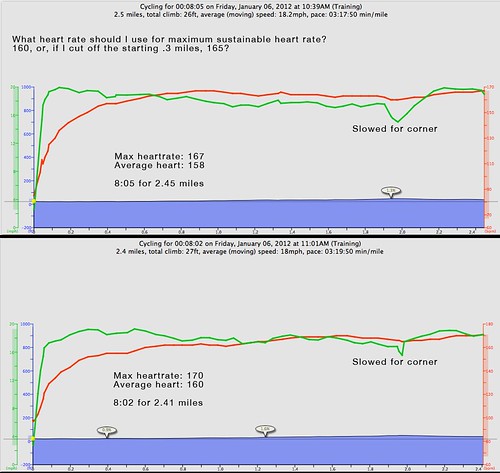
Here I am, armed with "The Time Crunched Cyclist" by Chris Carmichael, as if I'm actually going to train for the Slovang Double Century I signed up for. I know I'll ride a bunch, but the idea of planned training is intimidating.
The program starts with a test: find a flat road where you can ride for eight minutes without stopping.
From a near stop, accelerate and hammer as hard as you can for the eight minutes. Record your max heart rate, and average heart rate.
Sounds easy, but it isn't. Just finding a road was tough. I used Chestnut near the Byron Highway in Brentwood, a road was almost long enough, with one turn onto Sellars.
Starting was tough. I had to nearly stop, then hit the lap button on the Garmin while watching my stopwatch.
Riding as hard as I could was, well, hard. It hurt. I kept thinking, as my legs burned (shut up legs) "Do I have more?" and tried to give it.
While not backing off early, I tried to hit the lap button at eight minutes. I was off by five and two seconds.
Now I need to interpret the results.
My Max heart rates were 167 and 170. In the past on short effort hills efforts I've recorded 183 as a max.
My averages on these two runs were 158 and 160. But if I remove the startup heart rates I end up with 165. I did average 165 during a Mt. Diablo Hill Climb Time Trial. So did I ride hard enough this time? Did I have more? Would I have been able to achieve a higher heart rate if I worked harder? Could I have possibly worked harder? Are the previous highs hill related?
So, what number should I use for my maximum sustainable heart? It matters because that's what gets used to calculate the workouts.
I'm lost. I fear all I've really done is confirm that I'm really slow, and provided only confusing numbers that won't help me figure out what I need to do.
Maybe I should just go ride the bike.
The testing I had done at Davis years ago gave me two different numbers - one for flats and one for climbs. My "flat" number is lower than my climbing number.
ReplyDeleteGood luck!
Veronica
Not familiar with this book but I assume you're trying to calculate MaxHR & LTHR (Lactate Threshold). I have two solutions:
ReplyDeleteQuick one: any numbers you got from a race are better numbers. Experts agree (love that expression!) that you can never go as hard in 'training' as you can in a race. So use what you got on the Mt DIablo Trial, assuming it's a recent event.
Longer One:
1. establish your MaxHR by starting from a low speed on a flat road and increasing your speed by 1mph every minute. When you can no longer increase, you will have found your MaxHR (please consult a doctor first to make sure your heart can take the strain)
3. Establish your LTHR by doing an all out effort for 30 minutes and taking your Average HR for the last 20 minutes. That's your LTHR. (see http://www.electricblues.com/html/JoeFrielsQuickGuide.pdf)
One final note: whatever numbers you choose, just get on with the workouts and don't overthink it. You're supposed to retest periodically anyway (say 4-6 weeks) so you can adjust them. Your LTHR will change as you gain fitness, but I believe your MaxHR should change only with age. Although bear in mind that the heart has mind of its own and on any given day can be affected by stress, hydration levels, etc.
Thanks Veronica and Dean. I'm going to use 165 and go from there. I guess nothing is perfect. I wish I had some long flat roads close by, but I'm going to make do with the end of local Empire Mine Road, with it's minor uphill and a couple of bumps.
ReplyDelete